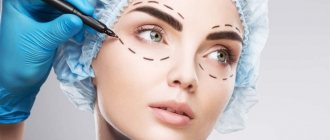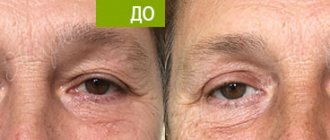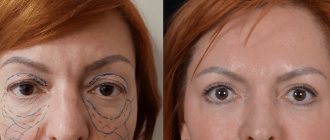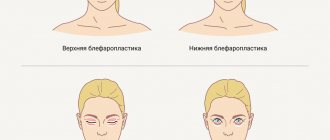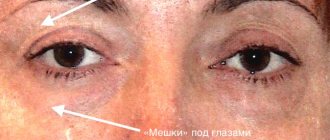The Greek word “ptosis” means “fall” and is used in medicine as a diagnosis of the descent of an organ downward from its anatomically normal natural position. Often found, for example, ptosis of the kidney, ptosis of the mammary gland, etc. In ophthalmology, a fairly common diagnosis is blepharoptosis, or drooping of the upper eyelid.
The severity of blepharoptosis can vary, from almost imperceptible asymmetry of the palpebral fissures to the total closure of one of the eyes. Due to the variety of possible causes of drooping eyelids, it is also impossible to single out the most susceptible age category: ptosis occurs in both newborns and very old people, i.e. can be either congenital or acquired. In some cases, only one eyelid is lowered, in others the ptosis is bilateral and symmetrical.
The cause of congenital drooping of the eyelid is the abnormal, incorrect and insufficient, intrauterine development of the levator muscle (this is the name of any lifting muscle in the body, including the muscle responsible for “raising the curtain” over the pupil). Another common cause is abnormalities of the nervous system caused by genetic malfunctions, various diseases or hazards during pregnancy, as well as complicated childbirth. As a rule, congenital drooping of the eyelid is only part of a complex congenital ophthalmopathology, which also includes amblyopia, anisocoria, strabismus, refractive errors (especially asymmetrical ones), etc.
Acquired ptosis is most often associated with three groups of factors and is etiologically classified as follows:
- aponeurotic ptosis is caused by weakness or stretching of the muscular aponeurosis of the eyelid (aponeurosis - tendon plate, “back of the eyelid”). In turn, incompetence of the aponeurosis can occur as a result of age-related aging processes (in this case they speak of involutional or senile aponeurotic ptosis); sometimes this is a complication after injury to the levator muscle or after ophthalmic surgery;
- neurogenic ptosis is a consequence of pathology of the central or peripheral nervous system; Given the rich innervation and close proximity of the eye to the brain (as well as direct electrochemical communication with it through the optic nerve), blepharoptosis can be caused by many different neurological diseases, including demyelinating pathology of the central nervous system (for example, multiple sclerosis), post-stroke defect, nervous paralysis and many others. In particular, Horner's syndrome is distinguished, which is characteristic of cervical sympathetic nerve palsy: this triad includes blepharoptosis, enophthalmos and miosis (respectively, drooping of the eyelid, retraction of the eyeball and constriction of the pupil).
Causes of ptosis of the upper eyelid
The term comes from a Greek word and means “overhanging or falling.”
The low location of the movable skin fold reduces the field of vision or completely disrupts it on the altered side. In this case, the anomaly can be congenital or acquired. It is considered normal if the cornea is covered by approximately 0.5-2 mm. If a muscle is atrophied or weakened, pathology occurs. Correct diagnosis allows the doctor to choose an adequate control strategy using therapeutic or surgical methods. The most common are:
- weakening of muscles;
- age-related gravitational changes;
- nerve ending paralysis;
- endocrine and other diseases;
- disruptions in the nervous system.
Among the reasons are diabetes mellitus and incorrect Botox injections.
Characteristic symptoms of eyelid ptosis
Overhanging mobile skin folds are observed at different stages of the disease. Externally, the disorder is expressed by uneven size of the eyelids, swollen skin, and a “sleepy” appearance. In addition, compensatory signs arise, such as the habit of throwing the head back, early wrinkles on the forehead, and the appearance of a raised eyebrow effect. The process of blinking is also difficult, which leads to increased fatigue and increases the risk of infection of the organs of vision. It is impossible to self-medicate in such cases; it is necessary to prescribe an examination, the purpose of which is to determine the causes of drooping of the upper eyelid in one eye and begin treatment only with strict adherence to the recommendations of a specialist.
The normal indicator is the distance from the edge of the skin fold to the central point of the pupil. It is assessed when the patient is examined by a doctor. Double vision and squint clearly indicate damage to the oculomotor nerve. Often there is a whole complex that combines ptosis and retraction of the eyeball. It is useless to solve problems one by one; the subject is prescribed an appropriate course of procedures. In the absence of results from conservative treatment, specialists resort to surgical correction.
Classification and stages of development
Like other pathologies, this one has its own characteristic features that make it possible to divide the total mass according to its external manifestation and prerequisites for its occurrence.
Neurological
It is also called neurogenic, since the root causes are disruptions in the central nervous system. In the vast majority of cases, the violation is observed on one side. If there is no clear functioning of the frontal and ocular muscles, then pathology occurs. These are the main causes of ptosis of the upper eyelid in adults. In this case, the bilateral appearance indicates a previous heart attack, and when the oculomotor nerve is damaged, pupil dilation is observed, and eye mobility is impaired. All cases are purely individual; the problem may spontaneously disappear when the affected area is stabilized. If treatment is necessary, the method is selected individually.
Myogenic blepharoptosis
Develops with myasthenia gravis, ocular myopathy, as a result of local or systemic muscle damage. There is also a toxic form associated with poisoning from lead or other heavy metals or their salts. Impairment of the motor function of the eye is possible, often accompanied by a decrease in the tone of the facial muscle tissue. How to correct ptosis of the upper eyelid in this case will become clear after a thorough detailed examination.
Mechanical view
Occurs if muscle function is hampered by scar formation, wearing lenses, or due to a tumor or injury. Sometimes only supportive procedures are required to stimulate natural regeneration. If the damage is very severe, then surgery is recommended.
Aponeurotic
This type is also called senile, when a person experiences stretching of muscles and ligaments and their weakening. In other cases, postoperative complications, cataract removal, severe infections, and injuries can trigger the disorder. Development occurs on both sides, but one is more affected. The congenital form is rare and occurs equally in men and women. Patients note a gradually progressive drooping of skin folds. To remove ptosis of the upper eyelid, surgical correction is indicated in most cases; the prognosis is favorable.
Pseudoptosis
In fact, this is a purely cosmetic problem. It is characterized by excess skin, which creates a severe fold that interferes with normal vision. Often it occurs in combination with age-related changes. To promptly refuse unnecessary or incorrect surgery, a comprehensive diagnosis is important. Treatment depends on the cause of the abnormality.
Traumatic blepharoptosis
When determining this type of disorder, experts recommend waiting 6 months before performing correction, since cases of spontaneous resolution of the situation are not uncommon. The etiology includes many factors and is diagnosed after the swelling has resolved. During the healing process, scarring and lagophthalmos are possible. If after time the condition does not improve, then muscle resection is performed. This is the best option to cure ptosis of the upper eyelid.
Rehabilitation after surgery
Operations to eliminate eyelid ptosis are truly a piece of jewelry that requires extreme precision, professionalism and, of course, appropriate equipment (magnifiers) and instruments. All internal sutures are made self-absorbing, and external sutures are removed after 12-15 days.
The result can be seen after about 2-3 weeks, when the hematomas and swelling disappear. The prognosis for surgery for ptosis is favorable. The aesthetic effect is achieved in almost 100% of cases, and the final restoration of the functional apparatus sometimes requires additional time and physical therapy.
Features of congenital pathology
In this case, part of the visual field is blocked, which causes dangerous complications to develop. In children of preschool and primary school age, a similar problem leads to delayed mental development, as well as the formation of complexes. There is a very high probability of progression of amblyopia, heterotopia, astigmatism, and binocular vision impairment.
Depending on the severity of the pathology and the individual characteristics of the patient’s body, a treatment regimen using conservative therapy is developed. If there is no result or the changes are too large, doctors prescribe surgery. Correction is a necessity, otherwise the omission leads to distortion of visual images in the child’s brain. The congenital form in the vast majority of cases will be transmitted from parents; a direct connection with a chromosomal malfunction is possible. Myasthenic ptosis is considered a variety, which is more visible externally in the evening; a characteristic symptom is quickly occurring fatigue of the facial muscles, especially in the area around the eyes.
Autoimmune diseases, intrauterine disorders of fetal formation, and tumors increase the risk of developing the disease. Congenital ptosis is also diagnosed in Duane and Horner syndromes; concomitant symptoms are narrowing of the palpebral fissures, deficiency of tear fluid, and deterioration in the quality of twilight vision.
Our advantages
"Moscow Eye Clinic" offers comprehensive diagnostics and effective treatment of various eye diseases. The use of the most modern equipment and the high professional level of specialists working in the clinic eliminate the possibility of diagnostic errors.
Based on the results of the examination, each visitor will be given recommendations on choosing the most effective methods of treating the eye pathologies identified in them. By contacting the Moscow Eye Clinic, you can be sure of quick and accurate diagnosis and effective treatment.
Author:
Fomenko Natalia Ivanovna 5/5 (1 rating)
Honey. portal:
Characteristics of acquired ptosis
The manifestation of the disease is often directly related to age-related changes in the body. In this case, the process proceeds unevenly, first one fold falls, then the second, and asymmetry may remain. Treatment of this type of disease is carried out exclusively by surgery. It is advisable to seek help at the initial stage. If complications arise from the excessive use of botulinum toxin drugs or the technology of its administration is violated, the muscles do not ensure the outflow of lymph, which provokes its accumulation, leading to large-scale edema.
The problem may arise due to individual intolerance to the drug and the unprofessionalism of the cosmetologist. In this case, it is necessary not only to correct the consequences, but also to select high-quality care products that will help speed up regeneration and stop age-related changes. A specialist will tell you how to get rid of ptosis of the face and upper eyelid after a full examination and tests. You should not rely on chance, since with advanced pathology, vision is impaired and strabismus occurs.
Blepharoplasty: stages
Upper eyelid correction surgery includes several stages:
- applying markings to the eyelid using a marker;
- applying a plate to the visual organs to protect against injury;
- an incision in the eyelid in the area designated by markings;
- moving the skin of the eyelid to the side to remove the fat layer;
- removal of excess skin;
- suturing;
- treatment with an anesthetic anti-inflammatory solution and application of a cold bandage.
Complications
The disease is not life-threatening. In most cases, the consequences are psychological in nature, provoking the emergence of complexes, the development of shyness, internal constriction from the awareness of a defect in appearance. A narrowing of the visual field and headaches also begin.
It is more difficult for children; progression of amblyopia and other disorders, including binocular vision, is possible. The outlines of objects are distorted, which causes partial disorientation in space. In severe forms, there is a high probability of developing a myasthenic crisis.
If the causes of facial ptosis and drooping upper eyelid are found, the doctor will tell you what to do, how to fight and remove the main symptoms. This will not be difficult, since the actions will be targeted, and the methods will be clearly selected and comprehensive.
Salon procedures in the fight against sagging
Surgical intervention is considered the most radical method. But the beauty industry has many more gentle and quite effective methods in its arsenal.
Hardware procedures
The list of the most popular:
- laser resurfacing;
- photorejuvenation;
- microcurrent therapy.
They improve the condition of the dermis and restore the collagen framework.
Peeling effectiveness
Chemical action on the surface and deeper layers triggers accelerated regeneration, while simultaneously eliminating dead cells that interfere with the absorption of nutrients. There are many types of such effects:
- dairy;
- almond;
- glycolic;
- pyruvic;
- Hollywood;
- retinoic.
The goal is to smooth and cleanse the surface of the epidermis, facilitating access to fresh, young, moisture-rich cells. As a result, the skin takes on a radiant appearance. Peeling is used not only for aesthetic purposes, but also for the treatment of skin diseases, including acne, papillomas, and dyschromia.
How threads help
Their goal is to restore the swollen oval and create an artificial frame that will confidently resist gravitational ptosis of the face. They can also be used for preventive purposes.
How injections can be useful
These measures already belong to the “heavy artillery”, since they are used in case of pronounced changes and are accompanied by microtraumas from the injection. Most often, injection vector lifting is recommended, which is one of the types of contour plastic surgery. During the procedure, a collagen frame is formed from natural fibers, which keeps tissues from sagging, reduces the depth of wrinkles and more clearly outlines the oval.
Lipofilling allows using the patient’s own fat to replenish the volume in the temporal and orbital problem areas.
Botulinum toxin will relax facial expressions, but will not eliminate them completely. As a result, the face will remain natural and mobile with a significant reduction in folds and creases. With its help, marionette wrinkles are effectively corrected.
Laser therapy
For initial ptosis of the upper eyelids, this procedure allows you to reduce the area of skin and reduce its overhang. It is worth considering that if the fold is too massive and this is a congenital anatomical feature, then conservative methods will not work; blepharoplasty must be performed. Laser is also effective as a rejuvenating agent. The action is aimed at destroying the upper dead layer of the epidermis with its further renewal. At the same time, the effectiveness is high, since after the first session, elastin and collagen, responsible for maintaining the frame, begin to be produced.
Cosmeceuticals against facial ptosis
Aging skin does not bring much pleasure, so it is necessary to look for ways to return a beautiful and tightened contour. It is better to prevent such changes by taking preventive measures. These include anti-aging care lines. You should only use products from well-known brands, which guarantee not only the effectiveness of use, but also the safety of the composition, the absence of allergic reactions and a sustainable effect. It is desirable that the list of ingredients include:
- hyaluronic and fruit acids;
- peptides;
- antioxidants;
- retinoids;
- vitamins C and E;
- Coenzyme Q10;
- biostimulants;
- phytoestrogens.
Each company has its own secret of effectiveness, but you need to pay attention not only to advertising slogans, but to select skin care products in accordance with the type of skin.
Diagnostics
It is worth considering that the most effective measures can be taken in the early stages of diseases. Unfortunately, at this stage it is very difficult to notice changes. You should be wary:
- visual enlargement of the skin fold;
- eyelid asymmetry;
- narrowing of the field of view;
- rapid fatigue of facial muscles;
- the desire to tilt your head back to examine a small detail in detail;
- the appearance of longitudinal wrinkles on the forehead.
If you suspect the development of pathology, you should contact a specialist to clarify the diagnosis. First of all, it is determined whether the anomaly is congenital or acquired. Next, an examination is carried out to determine the degree of prolapse. In case of vision problems, it is necessary to evaluate how much the field has narrowed, measure the eye pressure and examine the condition of the fundus. The next step is to check muscle tone and blinking function, and the quality of binocular vision.
Among the examinations that are prescribed:
- X-ray;
- MRI;
- Ultrasound;
- electromyography.
In some cases, with an unclear etiology, consultation with a neurosurgeon, endocrinologist, or neurologist may be necessary. The disease develops gradually.
1st degree
The upper eyelid hangs over the cornea or covers a third of the pupil. At this stage, there are quite a few options for how to treat eye ptosis. Basically, they are of a conservative direction, since there is no serious threat to visual acuity, the main concern is the cosmetic effect.
2nd degree
At this stage, half to two-thirds of the pupil closes, pain, headache, and overstrain of the muscles of the face and neck appear. Visually, the violation is clearly visible and causes not only psychological, but also physiological discomfort.
3rd degree
At this stage the pupil is completely closed. Surgery and long-term rehabilitation, including several stages, are required. The first step is to identify the causes, both the main ones and the accompanying ones. Only then can treatment be prescribed, constantly monitoring the patient’s well-being and the process of restoration of visual functions.
We recommend
GHC Placental Cosmetic - 3-D modeling mask with placenta hydrolyzate
Bb Laboratories – Regenerating placental-hyaluronic mask
Bb Laboratories – Anti-aging lifting cream
Bb Laboratories – Lifting patches
How to treat ptosis of the upper eyelid
There are several methods that are used depending on the causes of the disorder, the degree of its development and the individual characteristics of the human body. When congenital pathology is detected in the early stages, if vision is not impaired, comprehensive prevention is sufficient. If the problem is caused by Botox injections, then experts recommend waiting until the effect of the botulinum toxin wears off. In any case, the treatment regimen is developed individually.
Conservative treatment
Physiotherapeutic procedures are quite effective in eliminating blepharoptosis:
- massage;
- electrophoresis;
- UHF;
- microcurrent therapy.
The complex contains vitamin B and neuroprotectors. Gymnastics for the eyes is effective if the eyelids droop on their own due to aging of the body. A well-chosen program will help tighten muscles and restore them to their former tone.
Cosmeceuticals
With slight sagging tissue, you can completely get by with cosmetics. But they must be highly effective, not cause allergies, and have a tightening effect. Innovative original injection preparations, creams and serums made in Japanese and Korean from the RHANA Corporation, containing unique biologically active substances, allow you to stop the processes of premature aging, tighten and strengthen tissues, restore elasticity to the epidermis and lift the eyelid in a natural way.
- Patches for lifting and moisturizing with kinetin.
- Anti-aging lifting cream for the eye area “24 hours”.
Surgical method
Surgery is prescribed only in advanced stages, if the quality of vision is impaired or the consequences of injury interfere with normal work. To achieve the effect, the muscle is cut or shortened slightly. Rehabilitation lasts 3-4 weeks, under the supervision of a surgeon. The method allows you to completely get rid of pathology for life.
Types of postoperative complications
The most common is an allergy to local anesthetics. Swelling or the effect of incomplete closure of the eyelids may appear. Bleeding and infections are rare. Since the procedure is performed under local anesthesia. There are no serious consequences from anesthesia either. Sometimes keratitis is diagnosed, then the use of artificial tears and special gels is recommended.
Prevention
There are no targeted actions; indirect actions include regular examinations with an ophthalmologist, the use of cosmetic care products with a lifting effect for the eyelids and skin around the eyes, self-massage and maintaining the general tone of the body.



